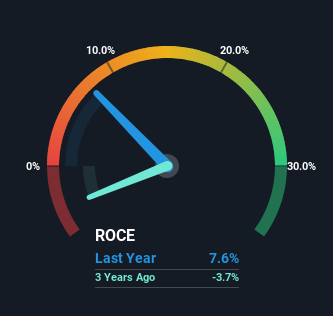- South Korea
- /
- Machinery
- /
- KOSDAQ:A103230
We Like These Underlying Return On Capital Trends At S&W (KOSDAQ:103230)

What trends should we look for it we want to identify stocks that can multiply in value over the long term? One common approach is to try and find a company with returns on capital employed (ROCE) that are increasing, in conjunction with a growing amount of capital employed. Ultimately, this demonstrates that it's a business that is reinvesting profits at increasing rates of return. With that in mind, we've noticed some promising trends at S&W (KOSDAQ:103230) so let's look a bit deeper.
Understanding Return On Capital Employed (ROCE)
For those that aren't sure what ROCE is, it measures the amount of pre-tax profits a company can generate from the capital employed in its business. To calculate this metric for S&W, this is the formula:
Return on Capital Employed = Earnings Before Interest and Tax (EBIT) ÷ (Total Assets - Current Liabilities)
0.076 = ₩4.0b ÷ (₩67b - ₩15b) (Based on the trailing twelve months to September 2023).
So, S&W has an ROCE of 7.6%. Even though it's in line with the industry average of 7.7%, it's still a low return by itself.
Check out our latest analysis for S&W

Historical performance is a great place to start when researching a stock so above you can see the gauge for S&W's ROCE against it's prior returns. If you'd like to look at how S&W has performed in the past in other metrics, you can view this free graph of S&W's past earnings, revenue and cash flow.
So How Is S&W's ROCE Trending?
We're delighted to see that S&W is reaping rewards from its investments and has now broken into profitability. The company now earns 7.6% on its capital, because five years ago it was incurring losses. Interestingly, the capital employed by the business has remained relatively flat, so these higher returns are either from prior investments paying off or increased efficiencies. With no noticeable increase in capital employed, it's worth knowing what the company plans on doing going forward in regards to reinvesting and growing the business. Because in the end, a business can only get so efficient.
For the record though, there was a noticeable increase in the company's current liabilities over the period, so we would attribute some of the ROCE growth to that. Effectively this means that suppliers or short-term creditors are now funding 22% of the business, which is more than it was five years ago. It's worth keeping an eye on this because as the percentage of current liabilities to total assets increases, some aspects of risk also increase.
Our Take On S&W's ROCE
To bring it all together, S&W has done well to increase the returns it's generating from its capital employed. Astute investors may have an opportunity here because the stock has declined 35% in the last five years. So researching this company further and determining whether or not these trends will continue seems justified.
On a separate note, we've found 1 warning sign for S&W you'll probably want to know about.
While S&W may not currently earn the highest returns, we've compiled a list of companies that currently earn more than 25% return on equity. Check out this free list here.
New: Manage All Your Stock Portfolios in One Place
We've created the ultimate portfolio companion for stock investors, and it's free.
• Connect an unlimited number of Portfolios and see your total in one currency
• Be alerted to new Warning Signs or Risks via email or mobile
• Track the Fair Value of your stocks
Have feedback on this article? Concerned about the content? Get in touch with us directly. Alternatively, email editorial-team (at) simplywallst.com.
This article by Simply Wall St is general in nature. We provide commentary based on historical data and analyst forecasts only using an unbiased methodology and our articles are not intended to be financial advice. It does not constitute a recommendation to buy or sell any stock, and does not take account of your objectives, or your financial situation. We aim to bring you long-term focused analysis driven by fundamental data. Note that our analysis may not factor in the latest price-sensitive company announcements or qualitative material. Simply Wall St has no position in any stocks mentioned.
About KOSDAQ:A103230
Adequate balance sheet with acceptable track record.
Market Insights
Community Narratives



